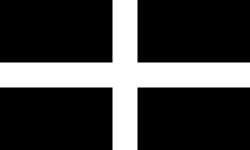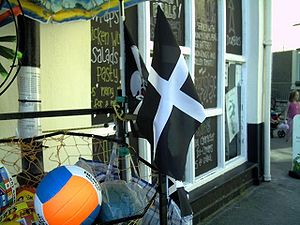Flag of Cornwall: Difference between revisions
mNo edit summary |
No edit summary |
||
| Line 16: | Line 16: | ||
[[File:Stpiraninpenwith.JPG|thumb|right|Saint Piran's Day celebrations in [[Penzance]]]] | [[File:Stpiraninpenwith.JPG|thumb|right|Saint Piran's Day celebrations in [[Penzance]]]] | ||
[[File:High ripples from Loe ground.jpg|thumb|right|Flying the flag in [[Portloe]]]] | [[File:High ripples from Loe ground.jpg|thumb|right|Flying the flag in [[Portloe]]]] | ||
'''The Cornish Flag''' is the flag of the [[Cornwall|county of Cornwall]]. The earliest known description of the flag as the Standard of Cornwall was written in 1838.<ref name=gilbert>[http://www.google.co.uk/books?id=oYYvAAAAMAAJ&pg=PA332&dq=formerly+the+banner+of+St.+Perran 'The Parochial History of Cornwall', by Davies Gilbert. (1838) Vol III, p. 332]</ref> It is used by | '''The Cornish Flag''' is the flag of the [[Cornwall|county of Cornwall]]. The earliest known description of the flag as the Standard of Cornwall was written in 1838.<ref name=gilbert>[http://www.google.co.uk/books?id=oYYvAAAAMAAJ&pg=PA332&dq=formerly+the+banner+of+St.+Perran 'The Parochial History of Cornwall', by Davies Gilbert. (1838) Vol III, p. 332]</ref> It is used by Cornish people as a symbol of identity.<ref name=rendle>[http://www.flaginstitute.org/pdfs/Phil%20Rendle.pdf Phil Rendle, Cornwall - The Mysteries of St Piran, The Flag Institute]</ref> It is a white cross on a black background. | ||
The flag is attributed to Saint Piran, a 6th century Cornish abbot. Saint Piran is supposed to have adopted these two colours from seeing the molten tin spilling out of the black ore in his fire. This occurred during his supposed discovery of tin in Cornwall, thus becoming the patron saint of tin miners. | The flag is attributed to Saint Piran, a 6th-century Cornish abbot. Saint Piran is supposed to have adopted these two colours from seeing the molten tin spilling out of the black ore in his fire. This occurred during his supposed discovery of tin in Cornwall, thus becoming the patron saint of tin miners. | ||
==Origins== | ==Origins== | ||
There are claims that the design dates from prior to 1188 when the flag was used in the Crusades,<ref>[http://www.celticleague.org/flags.html Celtic League flags]</ref> and an article in | There are claims that the design dates from prior to 1188 when the flag was used in the Crusades,<ref>[http://www.celticleague.org/flags.html Celtic League flags]</ref> and an article in Encyclopædia Britannica tells that the flag was carried by the Cornish contingent at the Battle of Agincourt (1415).<ref>[http://www.crwflags.com/fotw/flags/gb-corn.html Cornish flag]</ref> However, the reference given by Encyclopædia Britannica seems to have been confused with one that comes from a 1590 poem entitled ''"Poly-Olbion"'' by Michael Drayton. It states that the banner carried by the Cornish men at Agincourt depicted two Cornish Wrestlers in a hitch.<ref>''Poly-Olbion'' by Michael Drayton</ref> | ||
The earliest known evidence of this flag was recorded by Davies Gilbert in his 1838 work: 'The Parochial History of Cornwall', where he gives reference to..<blockquote>''"a white cross on a black ground [that] was formerly the banner of St Perran and the Standard of Cornwall; probably with some allusion to the black ore and the white metal of tin"''<ref name=gilbert/><ref name=rendle/></blockquote> | The earliest known evidence of this flag was recorded by Davies Gilbert in his 1838 work: 'The Parochial History of Cornwall', where he gives reference to..<blockquote>''"a white cross on a black ground [that] was formerly the banner of St Perran and the Standard of Cornwall; probably with some allusion to the black ore and the white metal of tin"''<ref name=gilbert/><ref name=rendle/></blockquote> | ||
| Line 32: | Line 32: | ||
<gallery> | <gallery> | ||
File:Kroaz Du.svg|The Standard of the Army of the Breton Duchy. | File:Kroaz Du.svg|The Standard of the Army of the Breton Duchy. | ||
File:Flag of Saint David.svg|The | File:Flag of Saint David.svg|The Flag of Saint David | ||
</gallery> | </gallery> | ||
Saint Piran's flag has similarities to the old Breton flag and the Flag of Saint David. The cultural links between Brittany, Wales and Cornwall are well recorded. Saint Piran's Flag is the negative image of the old Breton Flag, a black cross on a white field. The Flag of Saint David shares a black background with Saint Piran's Flag, but is surmounted by a gold, rather than a white, cross. | Saint Piran's flag has similarities to the old Breton flag and the Flag of Saint David. The cultural links between Brittany, Wales and Cornwall are well recorded. Saint Piran's Flag is the negative image of the old Breton Flag, a black cross on a white field. The Flag of Saint David shares a black background with Saint Piran's Flag, but is surmounted by a gold, rather than a white, cross. | ||
Revision as of 17:07, 12 December 2015
| Flag of Cornwall | |

| |
| Name | Saint Piran's Flag |
|---|---|
| Proportion | 3:5 |
| Design | Sable a cross Argent |
| Designed by | Traditional |




The Cornish Flag is the flag of the county of Cornwall. The earliest known description of the flag as the Standard of Cornwall was written in 1838.[1] It is used by Cornish people as a symbol of identity.[2] It is a white cross on a black background.
The flag is attributed to Saint Piran, a 6th-century Cornish abbot. Saint Piran is supposed to have adopted these two colours from seeing the molten tin spilling out of the black ore in his fire. This occurred during his supposed discovery of tin in Cornwall, thus becoming the patron saint of tin miners.
Origins
There are claims that the design dates from prior to 1188 when the flag was used in the Crusades,[3] and an article in Encyclopædia Britannica tells that the flag was carried by the Cornish contingent at the Battle of Agincourt (1415).[4] However, the reference given by Encyclopædia Britannica seems to have been confused with one that comes from a 1590 poem entitled "Poly-Olbion" by Michael Drayton. It states that the banner carried by the Cornish men at Agincourt depicted two Cornish Wrestlers in a hitch.[5]
The earliest known evidence of this flag was recorded by Davies Gilbert in his 1838 work: 'The Parochial History of Cornwall', where he gives reference to..
"a white cross on a black ground [that] was formerly the banner of St Perran and the Standard of Cornwall; probably with some allusion to the black ore and the white metal of tin"[1][2]
The fact that Gilbert identifies it as being 'formerly' a Standard of Cornwall implies that he believed it to have been used before 1838.[1] However, Gilbert did not leave a record of his background research, and referred only to his "recollection".[2]
One of the oldest depictions of the flag can be seen in a stained-glass window at Westminster Abbey. It was unveiled in 1888 in memory of the famous Cornish inventor and engineer Richard Trevithick. The window depicts St Michael at the top and nine Cornish saints, Piran, Petroc, Pinnock, Germanus, Julian, Cyriacus, Constantine, Nonna and Geraint in tiers below. The head of St Piran appears to be a portrait of Trevithick himself and the figure carries the banner of Cornwall.[6]
Clues to its origin
-
The Standard of the Army of the Breton Duchy.
-
The Flag of Saint David
Saint Piran's flag has similarities to the old Breton flag and the Flag of Saint David. The cultural links between Brittany, Wales and Cornwall are well recorded. Saint Piran's Flag is the negative image of the old Breton Flag, a black cross on a white field. The Flag of Saint David shares a black background with Saint Piran's Flag, but is surmounted by a gold, rather than a white, cross.
It has also been suggested that it may have been based on the arms of the Earl of Cornwall, or the later Duchy of Cornwall; based on the arms of other Cornish families; or be linked with the black and white livery of the Knights of St John.[2]
The flag is commonly understood to represent the white tin metal against the black tin ore; symbolically, however, the flag is said to represent the light of truth shining through the blackness/darkness of evil. Another theory of the black and white colours is that the white cross represents the igneous/metamorphic rocks of colour such as granite and schists mainly found in the southwest of Cornwall, while the black background represents the weathered Devonian slate and Carboniferous sandstone, both of which are mainly black-greyish in appearance, of the northern part of Cornwall.
Usage
The flag is widely displayed on cars and from buildings including those of Cornwall Council.[7] It is flown at most Cornish gatherings such as the Gorseth Kernow, St Piran's Day (5 March), Camborne's Trevithick Day (April), Padstow's 'Obby 'Oss festival (May), Helston's Flora Day (May), and at Cornish rugby matches. It is regularly seen around Cornwall on car stickers with the word Kernow (Cornish for Cornwall), and is used around the world as a symbol of the Cornish diaspora or overseas Cornish associations. It has been adapted for use in the logos of a number of organisations, such as the Cornwall district of the Methodist Church, is used by a variety of Cornish businesses such as Ginsters, and is seen on the design of the Cornish All Blacks rugby shirt as well as Cornish Pirates rugby logo.[7]
References
- ↑ 1.0 1.1 1.2 'The Parochial History of Cornwall', by Davies Gilbert. (1838) Vol III, p. 332
- ↑ 2.0 2.1 2.2 2.3 Phil Rendle, Cornwall - The Mysteries of St Piran, The Flag Institute
- ↑ Celtic League flags
- ↑ Cornish flag
- ↑ Poly-Olbion by Michael Drayton
- ↑ Westminster Abbey
- ↑ 7.0 7.1 How far has the “Cornish Revival” affected modern Cornwall?
Outside links
- Flags of the World - Speculations of the origins of this flag.
- The Flag Institute
| County flags of the United Kingdom |
|---|
|
Aberdeenshire • Anglesey • Banffshire • Bedfordshire • Berkshire • Berwickshire • Buckinghamshire • Caernarfonshire • Caithness • Cambridgeshire • Cheshire • Cornwall • Cumberland • Derbyshire • Devon • Dorset • Durham • East Lothian • Essex • Flintshire • Glamorgan • Gloucestershire • Hampshire • Herefordshire • Hertfordshire • Huntingdonshire • Kent • Kirkcudbrightshire • Lancashire • Leicestershire • Lincolnshire • Merionethshire • Middlesex • Monmouthshire • Morayshire • Norfolk • Northamptonshire • Northumberland • Nottinghamshire • Orkney • Oxfordshire • Pembrokeshire • Rutland • Shetland • Shropshire • Somerset • Staffordshire • Suffolk • Surrey • Sussex • Sutherland • Warwickshire • Westmorland • Wiltshire • Worcestershire • Yorkshire |

